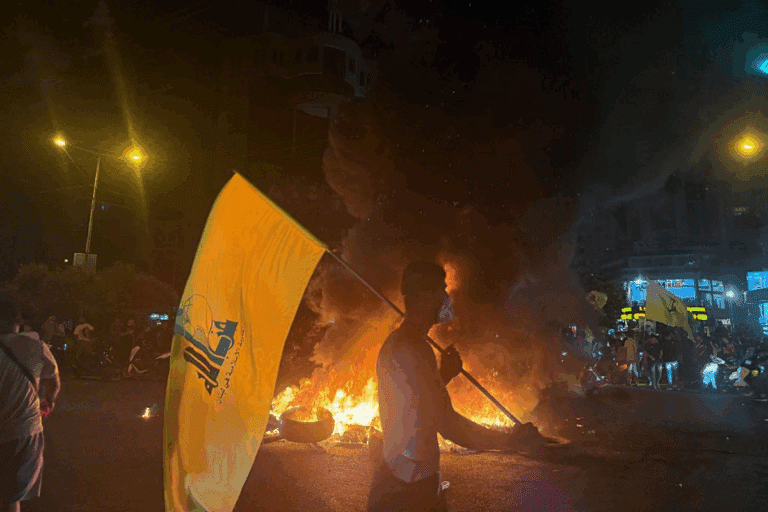
The Lebanese cabinet of ministers decided on Tuesday to force the demilitarization of the Iran-backed Hezbollah terrorist movement by the end of this year, as part of an international effort to reach a longer-lasting peace between Israel and Lebanon.
Hezbollah rejected the government’s decision, calling it a “grave sin” and saying that it would treat the decision “as if it does not exist.”
The terrorist movement warned that this decision would weaken Lebanon’s capabilities to confront Israel and the United States and “achieve for Israel what it did not achieve in its aggression against Lebanon.”
“This decision fully serves Israel’s interests and leaves Lebanon exposed to the Israeli enemy without any deterrence… The government’s decision is part of a surrender strategy and a clear disregard for the foundations of Lebanese sovereignty.”
Hezbollah added that it is open to discussing national security issues in Lebanon, but “not in the context of aggression.” The movement insisted that Israel isn’t holding up its side of the ceasefire agreement reached in November 2024.
Israel and Lebanon were at an impasse over a ceasefire agreement
On Oct. 8, 2023, one day after Hamas launched its Oct. 7 assault on southern Israel, Hezbollah began lobbing rockets, missiles, and drones toward northern Israel, forcing about 68,000 people to evacuate from their homes.
Tensions steadily intensified between Israel and Hezbollah. The terrorist group continued to launch rockets and drones toward northern and central Israel, while the IDF struck Hezbollah targets throughout Lebanon.
After nearly a year of war, tensions reached a peak after Israel eliminated Hezbollah’s leader, Hassan Nasrallah, in an airstrike on Beirut on Sept. 27. Just a few days later, the IDF launched an invasion of southern Lebanon, dismantling Hezbollah’s infrastructure throughout the region near the Israeli-Lebanese border.
In November, Israel and Hezbollah reached a ceasefire. As part of the agreement, Hezbollah committed to leave southern Lebanon and to dismantle any weapons production facilities in the country. Israel committed to fully withdraw from Lebanon within 60 days, but even after an extension, the IDF remained in five strategic locations along the border and has continued to conduct airstrikes on Hezbollah targets in recent months.
The strategic location of the five areas where the IDF remains in Lebanon constitutes a defense line that allows control and observation of areas that could be used to launch attacks on Israeli communities. While the enemy's intentions are not always assessable, its capabilities… pic.twitter.com/NvD1EdBUEi
— Israel-Alma (@Israel_Alma_org) February 18, 2025
Israel said Lebanon was violating the ceasefire by not cracking down hard enough on Hezbollah, pointing to the terrorist movement’s continued operations. Lebanon, in turn, said that Israel was violating the ceasefire by remaining in the five locations along the border and by continuing airstrikes even outside of southern Lebanon.
With both sides seemingly at an impasse, the United States stepped in to try to resolve the issues still on the table and to establish a lasting peace.
Why is Lebanon making this decision now?
A few days before the cabinet made its decision, the U.S. presented Lebanon with a detailed proposal that laid out guidelines to try to address both its and Israel’s concerns.
The Lebanese Nidaa Al Watan news site published on Thursday what it said was a full copy of the proposal presented by Tom Barrack, the U.S. ambassador to Turkey and a special envoy to Syria and Lebanon, to the Lebanese government.
The proposal is a 120-day plan in four phases to extend and stabilize the Lebanon-Israel ceasefire reached in November. In it, Barrack stresses that adopting the proposal is an urgent matter due to continued Israeli airstrikes “which risk triggering a collapse of the fragile status quo.”
Barrack’s proposal requires control over all weapons in Lebanon under the central government. This would mean disarming any armed forces not controlled by the state, mostly referring to Hezbollah. The proposal sets a deadline for this process by the end of this year, the same deadline set by the cabinet decision reached this week.
For years, the Lebanese Army has failed to act against Hezbollah, both because of a lack of willingness and a lack of ability.
Compared to the Iran-backed terrorist group, the Lebanese Army is relatively weak and relies heavily on foreign support. The Lebanese Army and political leadership, which Hezbollah is part of, have been concerned that acting against Hezbollah could spark a civil war.
In return for a commitment to demilitarize Hezbollah, Barrack offered increased international funding to help with reconstruction in Lebanon, as well as investment incentives to support the economy, which has been suffering from a severe crisis for years.
The proposal also calls for the IDF to withdraw from the five locations in Lebanon near the border in which it has remained in despite the ceasefire. A withdrawal from at least three of these points will need to be completed within the next 60 days and the full withdrawal within the next 90 days, according to the document. If Israel doesn’t comply, the U.S. has committed to censure it at the United Nations Security Council. Usually, the U.S. vetoes U.N. resolutions against Israel, so this is a pretty major commitment as UNSC condemnations usually have a larger effect on international relations than other U.N. decisions.
Israel and Lebanon will additionally need to hold negotiations concerning the final demarcation of the border between the two countries and the release of Lebanese prisoners held by Israel. Both nations dispute several locations along their shared borders, including an area called the Shebaa Farms. The proposal also calls for Syria and Lebanon to officially demarcate their shared borders, as the lack of clarity surrounding these borders has been central for weapons smuggling that has helped arm Hezbollah over the years.
Barrack stresses in the document that the U.S. and France will pressure Israel to ensure it fully implements its side of the agreement.
The U.S. is also offering further incentives for Lebanon to accept Barrack’s proposal, including an international conference to organize massive investments in the country.
On Thursday, the Lebanese cabinet announced it was adopting all the points of Barrack’s proposal. Ministers from Hezbollah and the Shi’ite Amal party left the cabinet meeting early in protest before the vote on the decision was made.
Before the meeting on Thursday, Lebanese President Joseph Aoun stressed that the U.S. proposal could only be fully implemented if Syria and Israel also agreed to it, and if the U.S. and France gave clear guarantees to ensure its enforcement.
Why is this decision sparking so much concern in Lebanon?
When Hezbollah was formed in 1982, Lebanon was in the throes of an intense civil war.
Lebanon is formed out of four major ethnic and religious groups: Shi’ite Muslims, Sunni Muslims, Maronite Christians, and the Druze.
For decades, these four groups have repeatedly fought with each other and among themselves over various issues. To try and resolve these issues, in 1943 the four groups agreed to the National Pact, splitting the powers of government between them based on their share of the population.
That Pact wasn’t enough to overcome the differences between the groups. A variety of issues exacerbated tensions, including disagreements about ties with the West, the feeling that non-Christian groups were disadvantaged by the Pact, pressure from Egypt and Syria for Lebanon to join a united Arab republic, and the entry of Palestinian terrorist groups who turned Lebanon into a base for attacks against Israel.
In 1975, fighting erupted between the Christian Phalange militia and the Lebanese National Movement, a group aligned with the Palestinians and Syria. The fighting escalated over a matter of months, eventually turning into a full-fledged civil war. Syria intervened directly, joining the war on the side of the Maronites, although its alliances shifted throughout the war.
The fighting continued for nearly 15 years, killing over 120,000 people and displacing over a million.
The situation was further complicated in 1982, when Israel invaded Lebanon in response to repeated attacks by Palestinian terrorists based there. Israel set up an established presence in southern Lebanon, allying with Christian militias in the civil war. Shortly after, Iran worked with Shia Muslims in Lebanon to form Hezbollah to push the IDF out. Israel withdrew from southern Lebanon in 2000, but Hezbollah kept its weapons and continued to attack the Jewish state.
Lebanon’s civil war largely ended in 1989 with the Taif Agreement, which adjusted the National Pact to make the balance of power between the different groups in Lebanon more equal and required all the militias in the country to disarm, except for Hezbollah.
Even with the agreement, though, the tensions between the different groups in Lebanon continued. Smaller clashes have erupted between the groups in the years since, including as recently as August 2023, when Christians in southern Lebanon clashed with Hezbollah terrorists who were carrying ammunition through their town.
With this long history of sectarian tensions, many in Lebanon are concerned that Hezbollah could react violently to any attempt to force them to demilitarize.
Before the cabinet’s meeting on Thursday, Sheikh Ahmad Qabalan, a Shi’ite cleric close to Hezbollah, warned that the meeting would either “put the country on the path toward stability and respecting national interests, or it may inflame the heart of its people, disregarding their sovereign interests.”
“There is no neutrality in this fateful issue, and any constitutional coup or national gamble will place the country in the heart of a crisis that could be the worst for national sovereign interests,” Qabalan added.
Hussein al-Nimr, a Hezbollah official in the Beqaa Valley, a Hezbollah stronghold, condemned the decision as an act of “surrender” on Thursday.
“The right solution is to lift the [Israeli] aggression, then discuss all other issues,” al-Nimr said. “Going in the opposite direction is political futility that will not change anything in our principles. We, in Hezbollah, do not deal with these situations with a hasty reaction, but if a confrontation is imposed on us, then every incident will be discussed separately.”
In a statement by its political wing, Hezbollah called the cabinet decision a “clear violation of the [National] Pact and a strike at the foundations of the Taif Agreement, which preserves Lebanon’s right to defend itself.”
“The national duo, partisan forces, national figures from all sects and backgrounds, and a broad national audience of Lebanese have expressed their clear position rejecting the Lebanese government’s position to strip Lebanon of its strength by attempting to pass a conspiracy to disarm the resistance in light of the intensification of Zionist aggression and the absence of any alternative capable of securing Lebanon’s defense and protecting the Lebanese, and the failure of the logic of guarantees that none of its Arab and international sponsors have committed to or fulfilled,” Hezbollah added.
On Thursday evening, Hezbollah supporters held rallies in the southern suburbs of Beirut, a Hezbollah stronghold, protesting the cabinet’s decision.
Other officials downplayed such concerns, insisting that Hezbollah and Amal were still working with the government.
After the cabinet meeting on Thursday, Labor Minister Mohammed Haidar, a Hezbollah politician, told Lebanese media that while party members left the meeting early, his party had not decided to withdraw from the government.
Information Minister Paul Morqos insisted that Hezbollah and Amal ministers who left the meeting on Thursday were only objecting to how the decision was being made, but were still committed to the content of the decision itself.
A Western official who is in contact with the Lebanese Army told Israel’s KAN broadcaster on Thursday that it has already been working to dismantle Hezbollah infrastructure in southern Lebanon on a daily basis. However, the Army has been preventing the publication of documentation of this effort due to fears that it will be portrayed as a collaborator working for Israel.
A source in UNIFIL, the U.N. peacekeeping force tasked with monitoring the conflict and ceasefires between Israel and Lebanon, added to KAN that over 300 weapons sites and caches in southern Lebanon have been discovered and reported to the Lebanese Army over the past few months.
📍Liban | Identification d’un réseau de tunnels et d’un important arsenal.💥
— Armée française – Opérations militaires (@EtatMajorFR) August 7, 2025
+200 soldats de @DAMAN_UNIFIL_FR mobilisés lors de l’opération Kemmel 2, en coopération avec @LebarmyOfficial, au plus près de la Blue Line.
🎯 Contribuer à la désescalade et la protection des civils,… pic.twitter.com/3JRjW7hmrh
On Thursday morning, the French military published photos showing French UNIFIL forces seizing weapons found in a tunnel in southern Lebanon. The weapons were seized in recent days, according to UNIFIL.
Originally Published Aug 7, 2025 06:15PM EDT


